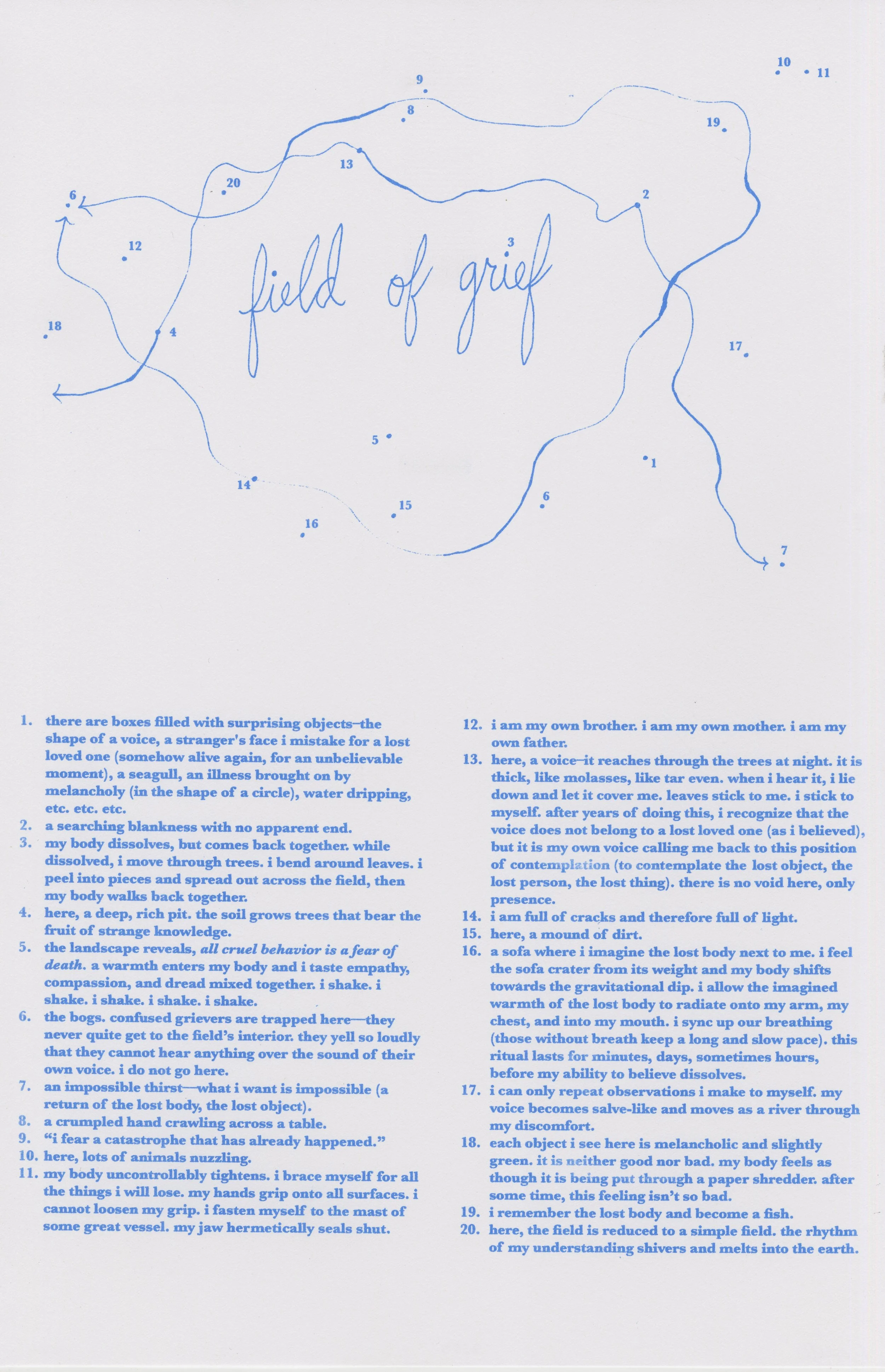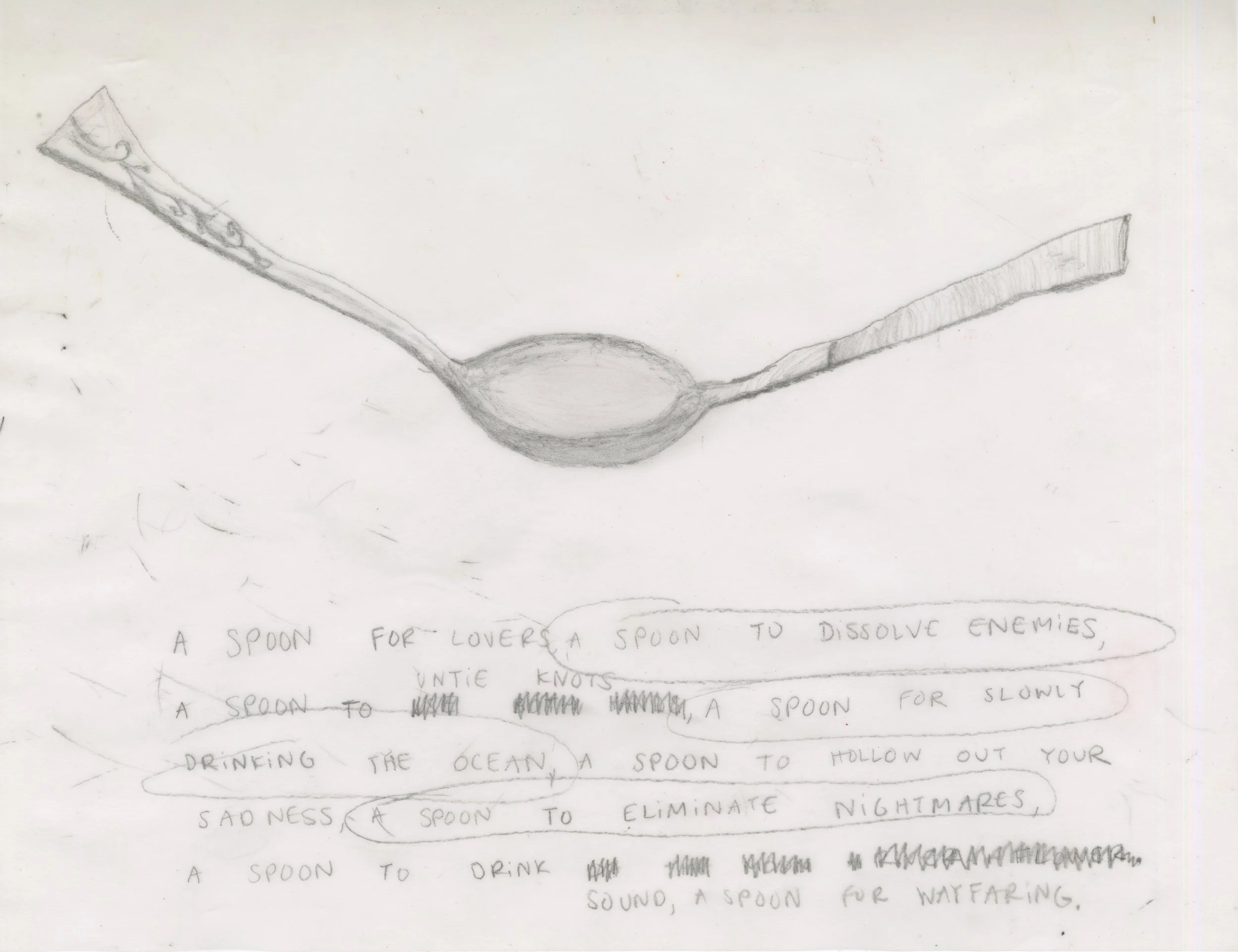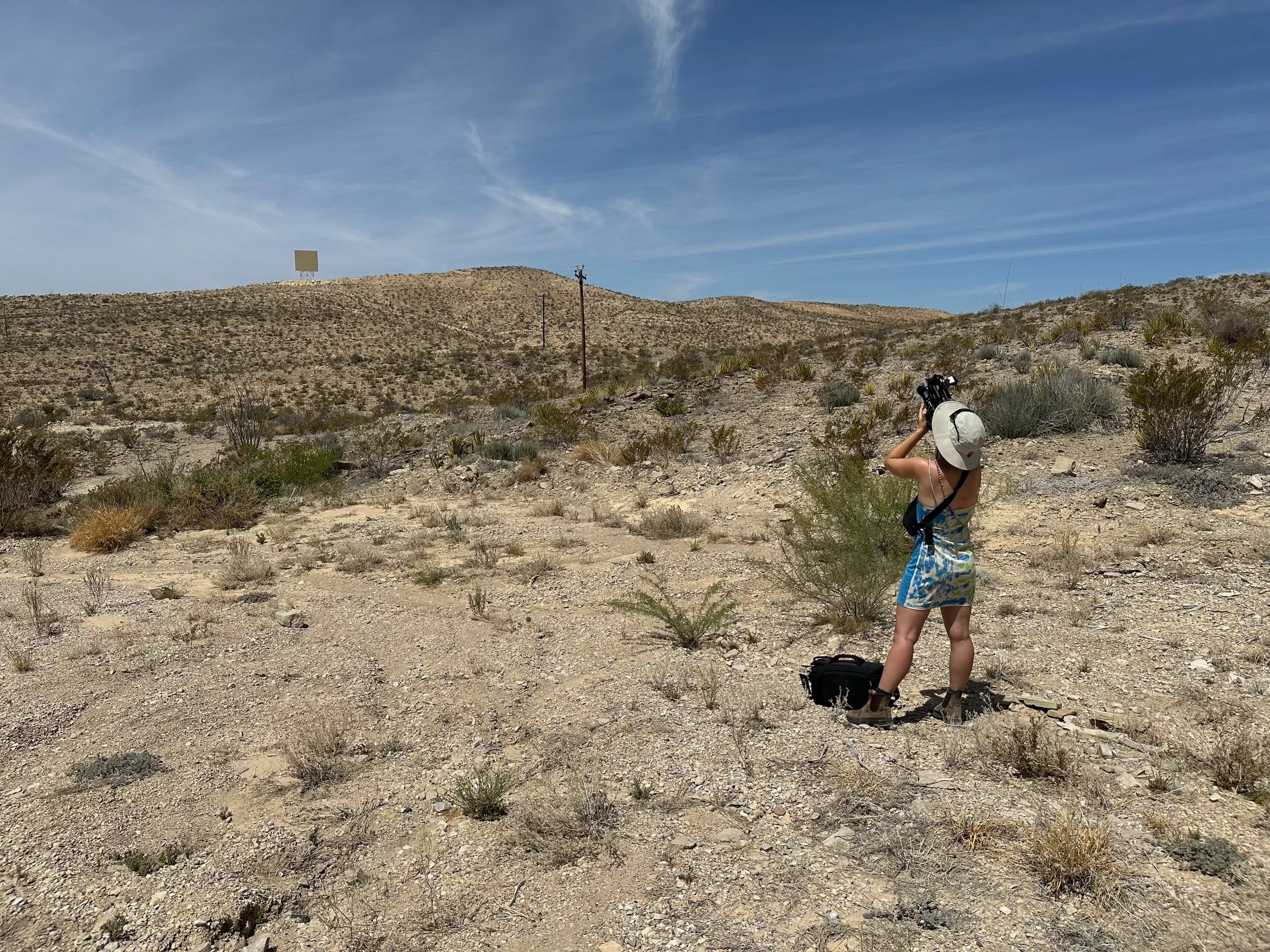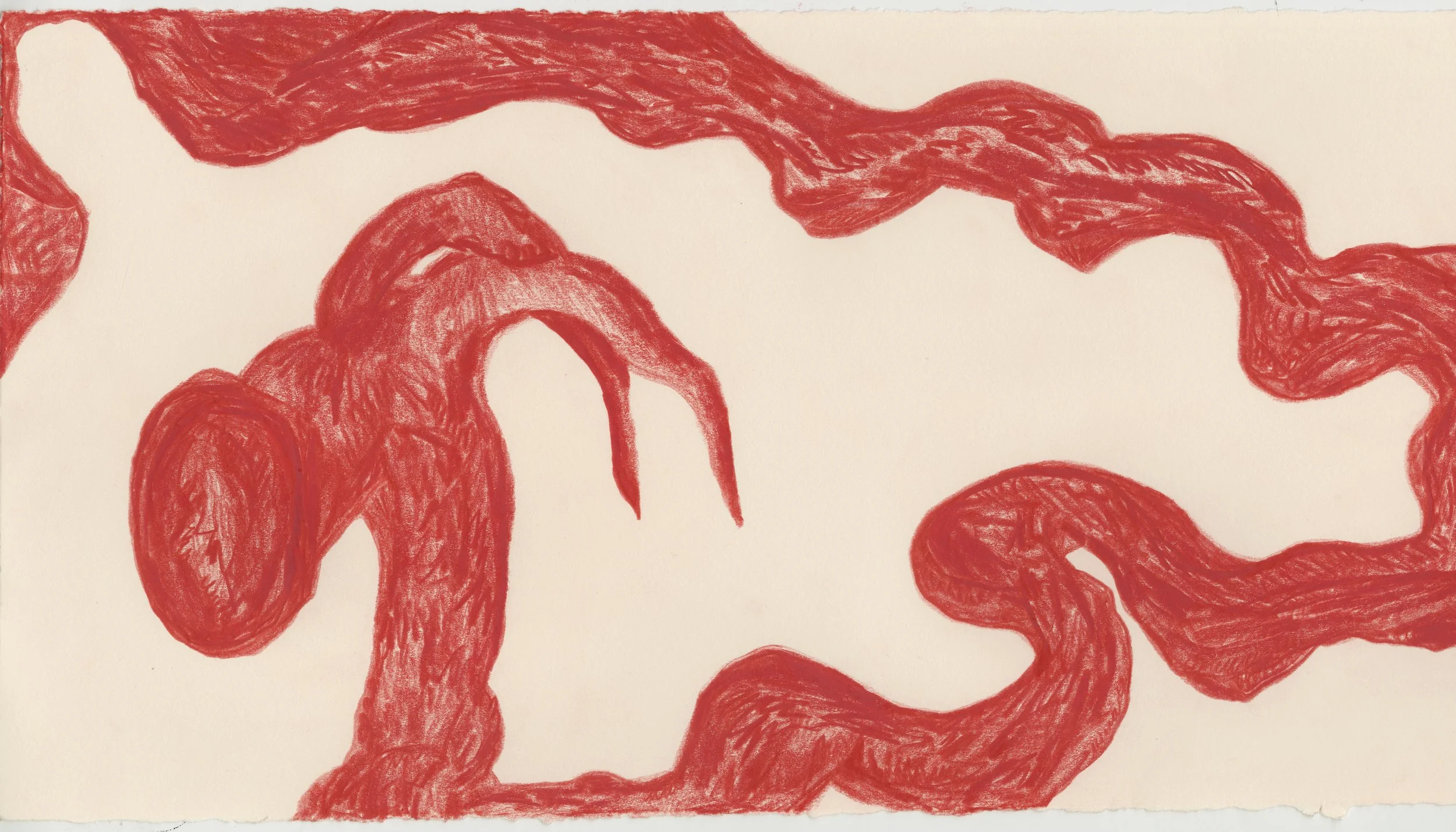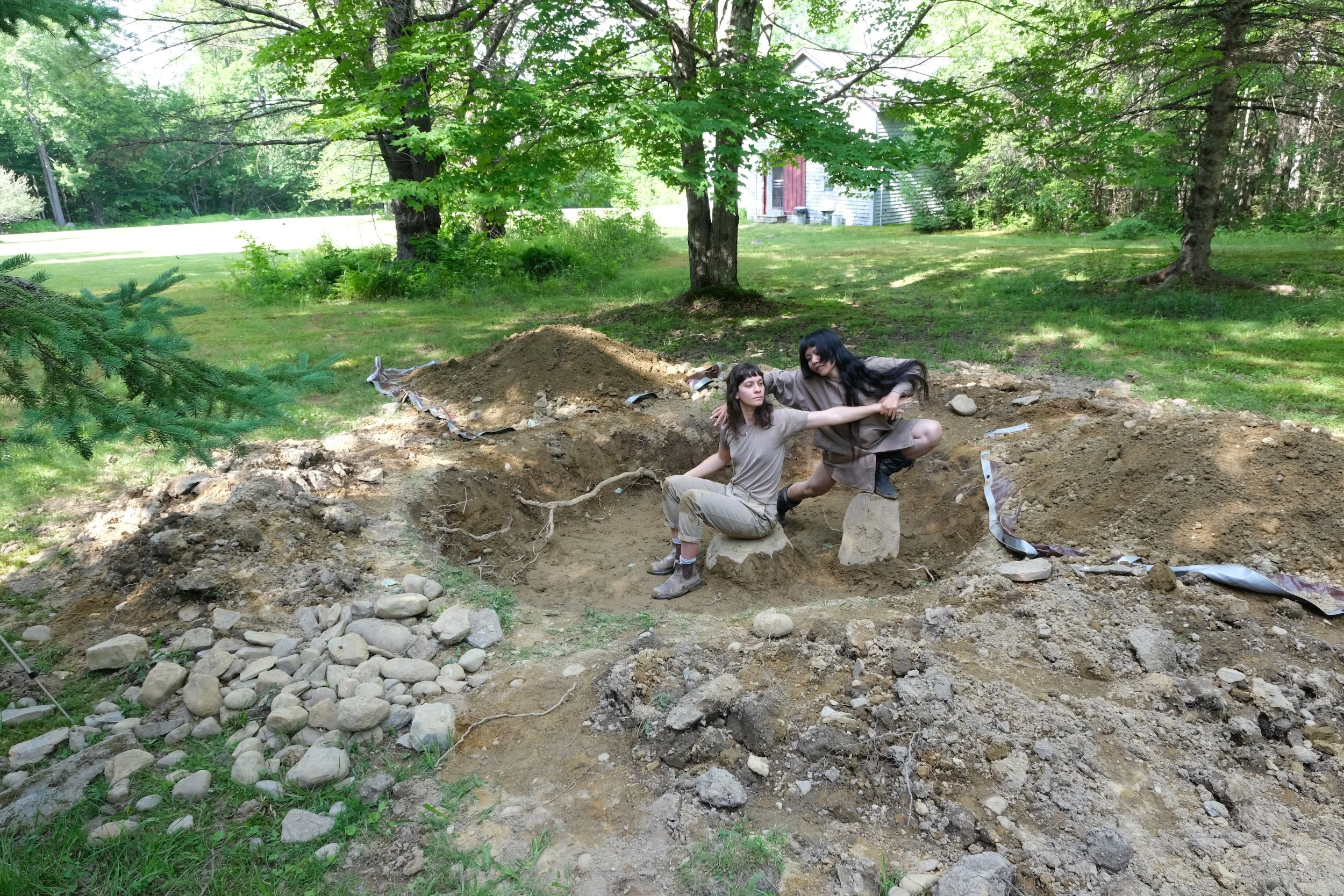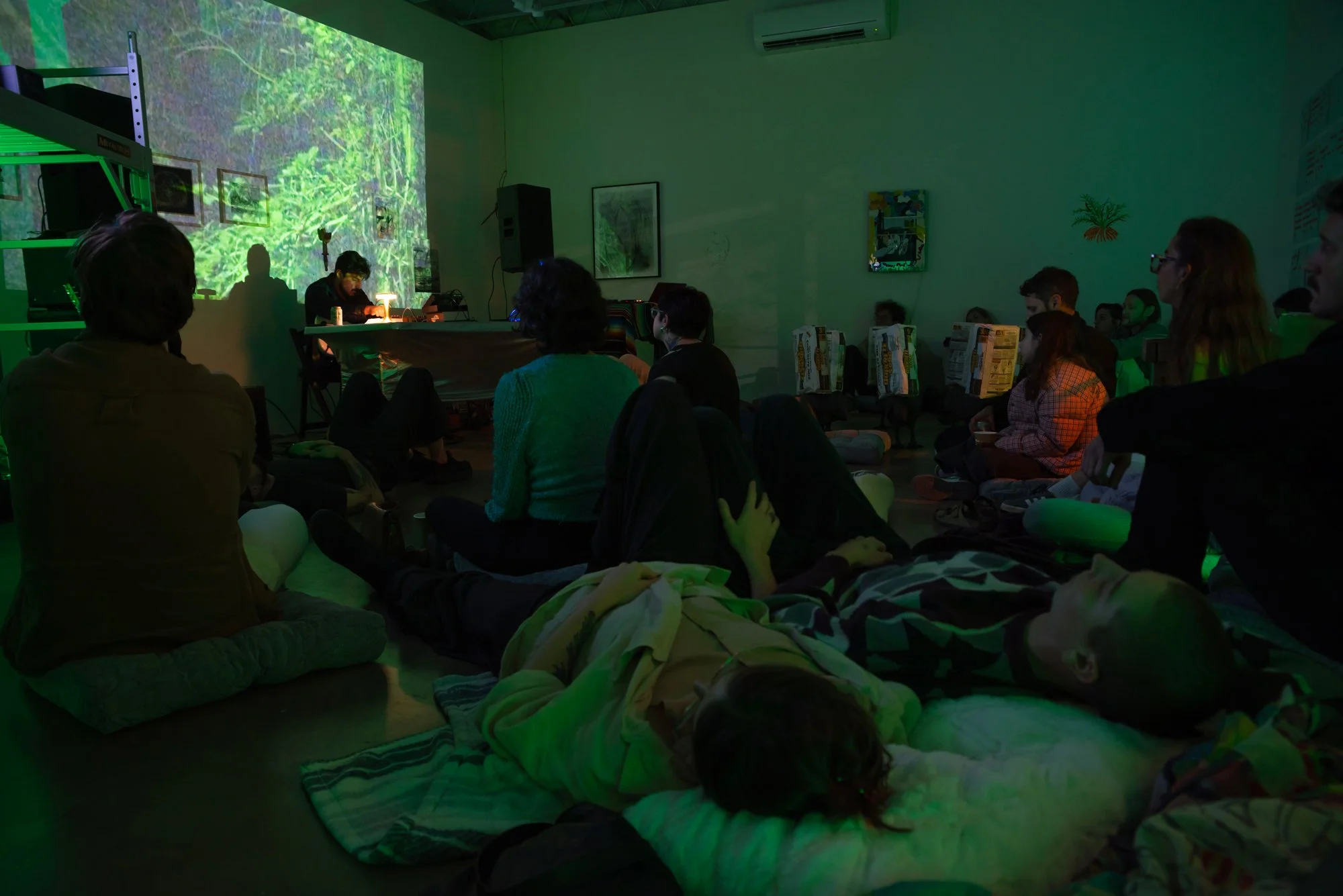Poetic action, dissolving into the landscape, and undoing myths of the American West: An interview with Hannah Spector
By Tiffany K. Smith
Hannah Spector is an interdisciplinary visual artist and poet who thinks of language as a solid object—a concrete and spatial expression that can overturn limiting perceptions of the everyday. I met Spector at the University of Texas at Austin where they teach Time & Technology classes and I am pursuing an MFA in Transmedia. I invited them to my studio where we discussed growing up near the sprawling artifice of Disney theme parks, the myth of the American West, and the inability to distinguish the real from the fake (a.k.a. hyperreality). I spoke with Spector about how poetry, teaching, and running an artist-run space have influenced their practice ahead of their solo exhibition, if you stare at a cowboy’s face long enough, it turns into a sunset, opening September 2025 at Women and Their Work in Austin, TX.
Hannah Spector, Courtesy of Rosie Clements.
Tiffany K. Smith (TKS): At a high level, how would you describe your practice? Is it studio-based? Do you follow a routine or formula? How has your background in poetry informed your art practice?
Hannah Spector (HS): I am not a creature of routine. I have also realized that I frequently reject working inside of a studio. I remember seeing the Gabriel Orozco Art21 when I was in undergrad and him calling himself a post-studio artist, and it gave me permission to do what I was intuitively doing. Of course, there is a practicality to having a studio for visits and storage, but most of my work is happening out in the world. I write as I move throughout my day and while I travel, I make sound recordings on walks, I carry around my camera and film, I collaborate with friends, etc. I like to make work in conversation with people, sounds, the landscape, architecture, or even the way I’m brushing my teeth or walking through a park. Solo studio time is necessary for production, but the more I can be around people, the better my work is. All of that being said, I did just move into a new studio that I am using as a production space for my show right now. I always feel a bit uneasy in a studio, but I’m actively working on changing that and seeing what the hesitation and discomfort is. I move towards what I push against because typically that space bears fruit.
Everything comes from the well of my writing, and I consider all of my work to be poetry that has risen into form. It is poetic action. Interestingly, my writing process is starting to have more of a form. What that concretely looks like is me sitting at home, printing out copies of my writings, reading them aloud, editing them, setting them to synth, editing them, reprinting them out, rereading them to myself, and on and on. I’ll print them out five to ten times before the poem gets finalized. A poem dies on the page if not spoken aloud. Language has a spatial aspect to it, and this helps me attune to it.
“field of grief”, Map of an unknowable feeling, Risograph, 2024.
TKS: Can you share a bit about your research and interests?
HS: I am interested in language. I love Critical Literary Theory and Semiotics and how poetry uses these preexisting structures of meaning and bends them to open language. This is a classic structuralist to post-structuralist mind journey, but I’m not sure I would totally call myself a post-structuralist. Essentially, I like to play with image-repertoires. We all have very specific image-repertoires in our heads, as in: “This object belongs with these other objects,” and “This object doesn’t belong with these objects,” etc. I like to play with that, to bend the everyday. Discovering object theater and artists like Stuart Sherman and Patty Chang blew my mind in graduate school.
As a researcher, I’m digging through performance art, video, and sound archives. I look to artists who use images in non-linear ways and to work that is more about texture than storytelling. I teach Time & Technology classes at The University of Texas at Austin and I was really struck this semester by students making work that looked and acted like a TikTok “Core-Core” video. The brain worm is in them, to the degree that they are reprocessing images in the same format as it was served to them. I feel increasingly nervous as I walk through campus and everybody is looking down. Obviously, the algorithm is feeding off of consumerist dopamine brain loops, so then my fascination becomes, “Okay, who goes against this? What is the antidote?” So, I look to artists that create visual or sonic experiences that remind me of my body, that slow me down, and think more of layered and non-linear experiences of time. There’s this really good Yoko Ono and John Lennon piece called, Up your Legs Forever, which is a video of them visually climbing the length of 367 people’s legs from toes to thighs. I like that. I also think my favorite video piece of all time is Ant Farm’s, Eternal Frame, which re-enacted the Kennedy assassination in Dallas twelve years after it happened. The resulting video is a conglomeration of performance, documentation, and reflection on why artists have the desire to do seemingly bizarre things.
“a spoon for slowly drinking the ocean,” graphite, 2023.
TKS: Your solo exhibition if you stare at a cowboy’s face long enough, it turns into a sunset at Women and Their Work in Austin is on the horizon. Can you talk about what you're working on for that show and some of the ideas behind it?
HS: Ever since I wrote that sentence (my title), I have repeated it to myself multiple times a day. I have a desire to dissolve into the land because it is so beautiful—into its air. On a very real level, the dissolution of the body into the land is the ultimate union. I subscribe to Buddhist philosophy, specifically Vajrayana Buddhism. In the Heart Sutra, there is this portion that states, “Form is emptiness and emptiness is form,” and I think about this as I drive through the desert. What is depicted as essentially an empty (movie) set in popular culture is one of the most active, vibrant landscapes with vibrational subtleties that reward deep listening and looking. At the same time, the desert is terrifying. I almost died backpacking with arts and landscape writer Sean J. Patrick Carney last spring in Big Bend. He didn’t almost die, it was just me, almost dying. But, yes, I am humbled by the desert. I love and fear and respect the desert and I want to make an ode to it, but not to the desert that is in the popular imagination.
Jean Baudrillard is my guy. Through his definition, the West is a collaged movie set that exists in our minds and not in reality—it is a hyperreality. The tumbleweed, the assless chaps, the saloon door swinging, the man spitting into a can—yeah, that’s very different from my experience of being out there, and I do like to go out there as much as I can. Especially since my mother’s family is Mexican, I relate to the area in a very different way. My show is aiming to queer and undo those symbols of the American West through poetic action and play.
Spector shooting in Terlingua, Texas for their upcoming show at W&TW. Courtesy of Sean J. Patrick Carney.
TKS: Who are some artists you're looking at right now? What books or films are you reading or watching?
HS: I’ve been rewatching all of Andrei Tarkovsky’s films. I’m also watching pop representations of the West like the 90s movie, Breakdown, which I highly recommend. I am reading The Hearing Trumpet by Leonora Carrington and some essays by Carl Jung. I’m watching a lot of Patty Chang’s performances and looking at Candice Lin, Brazilian architect Lina Bo Bardi, and the Czech-French photographer Josef Koudelka.
TKS: I saw you perform your poem Women Disappearing at Northern-Southern in Austin this past October. Can you talk a bit about that work and self-publishing it?
HS: This stems from my desire to dissolve into a landscape. I was reading Sylvia Federici last year and was thinking about the reproductive labor of women, and how that labor resists record keeping—it dissolves. I wrote eight short paragraphs about women’s experiences in solitude with the landscape, an imagined wholeness within that solitude, and a lack of record-keeping. The first one I wrote was about a woman feeding eggs to fish and then the fish convincing her to stay there because they loved her so much which is a mythopoetic completion, a circle of understanding.
I don’t understand publishing houses, I have always felt that self-publishing is best. I made an edition of five artist books. I hope to show them somewhere, but, for now, they are resting in my flat file and come out for readings or events.
“snake hammer,” wax, 2024.
TKS: You have attended several residencies, most recently Skowhegan with a number of other Texas-based artists. What was your experience like at Skowhegan? Any advice you can share on landing these opportunities?
HS: Talking and being in community with other artists is the best thing there is. This past summer I watched my friends Dylan Hausthor and Trae Story swim a taxidermied deer head through the lake for twenty minutes. I can’t think of a better June evening. The photo Dylan took made its way into the local newspaper.
On a practical level, I think the more you can expand your network, meet other artists, and help each other out, the better. I have never understood a competitive or scarcity mindset in art. You cannot physically take all of the opportunities and the opportunities you do get tend to come at the right time. I trust that. By creating a network, people will end up bringing you to lecture in their classes, curate your work into a show, or hire you to do performances. Opportunities will open up and you can reciprocate.
The more I talked to people at Skowhegan, the more I realized the process of getting in is, of course, partly skill, but mostly luck. It depends on who is on the panel and what mood they are in on that day. My advice is to be as clear as possible in applications. Do not use confusing language; they will move on if they cannot understand you. Use direct language. As a writer, I care about this: don’t say you are attempting to do something, just say you do it.
Skowhegan was physically very hard for me, but very rewarding. Climate change has hit Maine! There was a lot of high heat, no AC, and a lot of humidity. For my sad asthmatic lungs, it really slowed me down and limited what I was able to do and make. I ended up collaborating with a lot of people on playing music and making performances that led nowhere except to a good time. Ultimately, I made great friends and got to go to adult summer camp. I’m surprised at the way it keeps giving after I have left, it is a mysterious place. One night at 1:00am I sat in the sculpture pavilion and thought that, for over 80 years artists have been coming to this one place to be together. It feels meaningful to be a part of that history and it is palpable when you are there.
“mud spa” Performance-still from “Mud Spa,” with Lele Dai, Skowhegan, 2024.
TKS: Out of the many exhibitions, festivals, and residencies that you’ve participated in, can you talk about a couple of opportunities that were especially meaningful to you?
HS: Getting curated into the Contemporary Art Month Perennial my first year out of graduate school was very affirming. The curator called me punk-rock in an interview and I enjoyed that. But, being a part of MASS Gallery in Austin has been the biggest game changer for me. It has fed my spirit and soul in so many ways. After graduate school, I had a lot of voices in my head telling me what I should make and how I should make it and that I needed to go to New York or LA to be successful. MASS showed me that I could make art, have a lot of fun doing it, and make big communal events where other people have fun too. Being a part of MASS solidified how I make art: in a very personal, experiential, and communal way.
TKS: How and when did you get involved with MASS Gallery in Austin? How did being part of an artist-run space inform your practice?
HS: I had the HOTBOX residency in 2021 and became a member shortly thereafter. I served as the Secretary of MASS for about two years and was a member for three. I did recently step down as a member and as secretary after a lot of reflecting. I had to be realistic about balancing my teaching, personal practice, and health but, I still curate MASS Ambient in partnership with the gallery, which is an ongoing ambient night event and project. I’ll always have one foot in the door there, but I’m on the outside now! I don’t truly feel outside, because all those people are still a huge part of my community and resource network. MASS taught me so much about community, gave me resources, and showed me a world outside of institutions. My favorite part was getting to hang with intergenerational Austin artists, seeing the ways they have made their lives work as artists, and admiring the crazy DIY shit they do that feeds the scene! On a practical level, I also got to see what it takes to run a space, get funding, balance a budget, and professionally put shows on at a semi-large scale.
For three years my life was MASS and it was beautiful. My entire practice was centered around community events, immersive experiences, and getting other artists paid. Now it feels more fluid and comfortable to work with a group of people to accomplish projects. Resource-sharing is the biggest thing you can do as a member of a community. Help everybody out and lend what you can and the favor will be returned through the divine grace of the resource gods.
Photo of MASS Ambient, by Rosie Clements.
TKS: What advice do you have for an artist looking to join an arts collective or organize an artist-run space?
HS: If you like a place, go hang out there, talk to the people that run it, and apply to any open calls they have. This method works in both directions: you get to try out whether or not you want to be a part of it and they get to see if you fit. Also, be realistic about what resources and time you have to give and only give what you can. You’ll be surprised at how much you can give! Know that everybody has different strengths and do the best you can to bring those strengths out in others and to share yours.
TKS: You’ve been teaching art since 2016 both in and out of art institutions. How has teaching art informed your practice?
HS: Teaching allows me more time to think, read, and practice my skills. My video editing and printmaking abilities have gotten 30000% better from solving students’ technical issues. I did realize the other day that as a human I have dedicated my life–in a very real way–to the transmission of knowledge surrounding art process, theory, and history. We all carry forth some type of knowledge and this is what I choose to perpetuate as a framework of making meaning in the world.
To me, teaching is allowing students to realize it is okay to fail really hard, make bizarre work, and experiment. Capitalism has a death grip on all of us and the classroom can be a place to undo a lot of that toxic mind bending. I center Deborah Hay’s question “If my body could move in any way it wanted to move, how would it move? Away from how it was conditioned.” An arts education opens up a very sane way to approach the world: through openness, experimentation, and deep looking and listening. I know this is a very particular approach, but students open up and make beautiful things if you center that ethos in the classroom.
You can see more of Hannah’s work on their website and catch their solo show if you stare at a cowboy’s face long enough, it turns into a sunset at Women & Their Work in Austin September 27, 2025 - November 13, 2025



